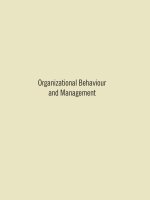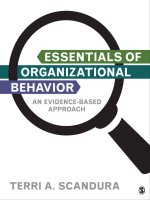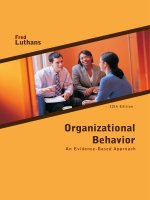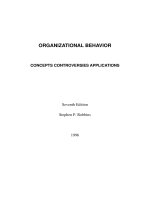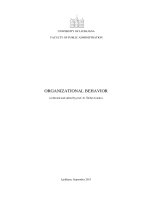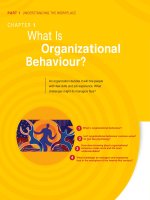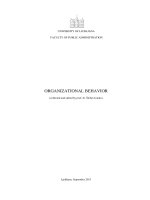Organizational behavior
Bạn đang xem bản rút gọn của tài liệu. Xem và tải ngay bản đầy đủ của tài liệu tại đây (7.39 MB, 696 trang )
Chapter 1
Organizational Behavior
LEARNING OBJECTIVES
After reading this chapter, you should be able to understand and articulate
answers to the following questions:
1. What is organizational behavior (OB)?
2. Why does organizational behavior matter?
3. How can I maximize my learning in this course?
4. What research methods are used to study organizational behavior?
5. What challenges and opportunities exist for OB?
Employees Come First at Wegmans
Ever since Fortune magazine created its list of the 100 Best Companies to
Work For, Wegmans has consistently remained within its ranks. In 2007,
Wegmans was given the Food Network’s award as the nation’s top
supermarket. Wegmans is a thriving grocery store chain based in Rochester,
New York, that grew to 71 stores across Maryland, New Jersey, New York,
Pennsylvania, and Virginia by 2008. Wegmans is a family-run business.
Daniel Wegman, the current CEO, is the grandson of the company’s
cofounder. Daniel’s daughter Colleen Wegman is president of the company.
The Fortune magazine ranking came as a surprise to many in the grocery
industry, as Wegmans is characterized by low profit margins, low-paying and
tedious jobs, and demanding customer interactions.
There are many reasons that Wegmans has such loyal workers and a turnover
rate of only 8% for their 35,000 employees (compared to the industry average,
which is closer to 50%). They utilize job sharing and a compressed workweek
Saylor URL: />
Saylor.org
2
/>
and also offer telecommuting for some employees. Ultimately, Wegmans
created an environment that shows employees they matter. The company
motto is “Employees first. Customers second” is based on the belief that when
employees feel cared for, they will in turn show concern for the customers they
serve. In response to the 2008 ranking as the third best company in the
United States to work for, CEO Danny Wegman said, “Every one of our
employees and customers should stand up and take a bow, because together
they make Wegmans a special place.”
Wegmans has also consistently brought innovations to a fairly traditional
industry. For example, Wegmans launched a Web site for its stores in 1996
with specifics on health and recipes and other helpful information for its
customers. Many have called the experience at Wegmans “Food Theater.”
With sales of organic foods in the United States soaring to $17 billion,
Wegmans supermarkets started its own 50-acre organic research farm. Its
goal is to develop best practices in terms of health and efficiency and to share
those practices with the hundreds of farmers that supply their stores with
fresh fruits and vegetables.
Wegmans is demonstrating that being both socially and environmentally
responsible can increase employee loyalty, growth, and profits, creating a
win–win situation for the organization, important stakeholders such as
employees and customers, and the communities where they are located.
Sources: Based on information contained in Ezzedeen, S. R., Hyde, C. M., &
Laurin, K. R. (2006). Is strategic human resource management socially
responsible? The case of Wegmans Food Markets, Inc. Employee
Responsibility and Rights Journal,18, 295–307; Niedt, B. (2008, January 22).
Wegmans no. 3 on Fortune’s “Best companies to work for” list. The PostSaylor URL: />
Saylor.org
3
/>
Standard; Borden, M., Chu, J., Fishman, C., Prospero, M. A., & Sacks, D.
(2008, September 11). 50 ways to green your business. Fast Company.
Retrieved January 27, 2008, from
100 best companies to work for. (2008). Retrieved January
27, 2008, from the Fortune Web site:
/>3.html.
1.1 Understanding Organizational Behavior
LEARNING OBJECTIVES
1. Learn about the layout of this book.
2. Understand what organizational behavior is.
3. Understand why organizational behavior matters.
4. Learn about OB Toolboxes in this book.
About This Book
The people make the place.
Benjamin Schneider, Fellow of the Academy of Management
This book is all about people, especially people at work. As evidenced in the
opening case, we will share many examples of people making their workplaces
work. People can make work an exciting, fun, and productive place to be, or
they can make it a routine, boring, and ineffective place where everyone
dreads to go. Steve Jobs, cofounder, chairman, and CEO of Apple Inc.
attributes the innovations at Apple, which include the iPod, MacBook, and
iPhone, to people, noting, “Innovation has nothing to do with how many R&D
Saylor URL: />
Saylor.org
4
/>
dollars you have.…It’s not about money. It’s about the people you have, how
you’re led, and how much you get it.” [1] This became a sore point with
investors in early 2009 when Jobs took a medical leave of absence. Many
wonder if Apple will be as successful without him at the helm, and Apple stock
plunged upon worries about his health. [2]
Mary Kay Ash, founder of Mary Kay Inc., a billion-dollar cosmetics company,
makes a similar point, saying, “People are definitely a company’s greatest
asset. It doesn’t make any difference whether the product is cars or cosmetics.
A company is only as good as the people it keeps.” [3]
Just like people, organizations come in many shapes and sizes. We understand
that the career path you will take may include a variety of different
organizations. In addition, we know that each student reading this book has a
unique set of personal and work-related experiences, capabilities, and career
goals. On average, a person working in the United States will change jobs 10
times in 20 years. [4] In order to succeed in this type of career situation,
individuals need to be armed with the tools necessary to be lifelong learners.
So, this book will not be about giving you all the answers to every situation you
may encounter when you start your first job or as you continue up the career
ladder. Instead, this book will give you the vocabulary, framework, and critical
thinking skills necessary for you to diagnose situations, ask tough questions,
evaluate the answers you receive, and act in an effective and ethical manner
regardless of situational characteristics.
Throughout this book, when we refer to organizations, we will include
examples that may apply to diverse organizations such as publicly held, forprofit organizations like Google and American Airlines, privately owned
businesses such as S. C. Johnson & Son Inc. (makers of Windex glass cleaner)
Saylor URL: />
Saylor.org
5
/>
and Mars Inc. (makers of Snickers and M&Ms), and not-for-profit
organizations such as the Sierra Club or Mercy Corps, and nongovernmental
organizations (NGOs) such as Doctors Without Borders and the International
Red Cross. We will also refer to both small and large corporations. You will see
examples from Fortune 500 organizations such as Intel Corporation or Home
Depot Inc., as well as small start-up organizations. Keep in mind that some of
the small organizations of today may become large organizations in the future.
For example, in 1998, eBay Inc. had only 29 employees and $47.4 million in
income, but by 2008 they had grown to 11,000 employees and over $7 billion
in revenue. [5] Regardless of the size or type of organization you may work for,
people are the common denominator of how work is accomplished within
organizations.
Together, we will examine people at work both as individuals and within work
groups and how they impact and are impacted by the organizations where they
work. Before we can understand these three levels of organizational behavior,
we need to agree on a definition of organizational behavior.
What Is Organizational Behavior?
Organizational behavior (OB) is defined as the systematic study and
application of knowledge about how individuals and groups act within the
organizations where they work. As you will see throughout this book,
definitions are important. They are important because they tell us what
something is as well as what it is not. For example, we will not be addressing
childhood development in this course—that concept is often covered in
psychology—but we might draw on research about twins raised apart to
understand whether job attitudes are affected by genetics.
Saylor URL: />
Saylor.org
6
/>
OB draws from other disciplines to create a unique field. As you read this
book, you will most likely recognize OB’s roots in other disciplines. For
example, when we review topics such as personality and motivation, we will
again review studies from the field of psychology. The topic of team processes
relies heavily on the field of sociology. In the chapter relating to decision
making, you will come across the influence of economics. When we study
power and influence in organizations, we borrow heavily from political
sciences. Even medical science contributes to the field of organizational
behavior, particularly to the study of stress and its effects on individuals.
Figure 1.3
OB spans topics related from the individual to the organization.
Those who study organizational behavior—which now includes you—are
interested in several outcomes such as work attitudes (e.g., job satisfaction
and organizational commitment) as well as job performance (e.g., customer
Saylor URL: />
Saylor.org
7
/>
service and counterproductive work behaviors). A distinction is made in OB
regarding which level of the organization is being studied at any given time.
There are three key levels of analysis in OB. They are examining the
individual, the group, and the organization. For example, if I want to
understand my boss’s personality, I would be examining the individual level of
analysis. If we want to know about how my manager’s personality affects my
team, I am examining things at the team level. But, if I want to understand
how my organization’s culture affects my boss’s behavior, I would be
interested in the organizational level of analysis.
Why Organizational Behavior Matters
OB matters at three critical levels. It matters because it is all about
things you care about. OB can help you become a more engaged
organizational member. Getting along with others, getting a great job,
lowering your stress level, making more effective decisions, and working
effectively within a team…these are all great things, and OB addresses them!
It matters because employers care about OB. A recent survey by the
National Association of Colleges and Employers (NACE) asked employers
which skills are the most important for them when evaluating job candidates,
and OB topics topped the list. [6]
The following were the top five personal qualities/skills:
1. Communication skills (verbal and written)
2. Honesty/integrity
3. Interpersonal skills (relates well to others)
4. Motivation/initiative
5. Strong work ethic
Saylor URL: />
Saylor.org
8
/>
These are all things we will cover in OB.
Finally, it matters because organizations care about OB. The best
companies in the world understand that the people make the place. How do
we know this? Well, we know that organizations that value their employees are
more profitable than those that do not.[7] Research shows that successful
organizations have a number of things in common, such as providing
employment security, engaging in selective hiring, utilizing self-managed
teams, being decentralized, paying well, training employees, reducing status
differences, and sharing information. [8] For example, every Whole Foods store
has an open compensation policy in which salaries (including bonuses) are
listed for all employees. There is also a salary cap that limits the maximum
cash compensation paid to anyone in the organization, such as a CEO, in a
given year to 19 times the companywide annual average salary of all full-time
employees. What this means is that if the average employee makes $30,000
per year, the highest potential pay for their CEO would be $570,000, which is
a lot of money but pales in comparison to salaries such as Steve Jobs of Apple
at $14.6 million or the highest paid CEO in 2007, Larry Ellison of Oracle, at
$192.9 million. [9] Research shows that organizations that are considered
healthier and more effective have strong OB characteristics throughout them
such as role clarity, information sharing, and performance feedback.
Unfortunately, research shows that most organizations are unhealthy, with
50% of respondents saying that their organizations do not engage in effective
OB practices. [10]
In the rest of this chapter, we will build on how you can use this book by
adding tools to your OB Toolbox in each section of the book as well as
assessing your own learning style. In addition, it is important to understand
the research methods used to define OB, so we will also review those. Finally,
Saylor URL: />
Saylor.org
9
/>
you will see what challenges and opportunities businesses are facing and how
OB can help overcome these challenges.
Adding to Your OB Toolbox
Your OB Toolbox
OB Toolboxes appear throughout this book. They indicate a tool that you can
try out today to help you develop your OB skills.
Throughout the book, you will see many OB Toolbox features. Our goal in
writing this book is to create something useful for you to use now and as you
progress through your career. Sometimes we will focus on tools you can use
today. Other times we will focus on things you may want to think about that
may help you later. As you progress, you may discover some OB tools that are
particularly relevant to you while others are not as appropriate at the moment.
That’s great—keep those that have value to you. You can always go back and
pick up tools later on if they don’t seem applicable right now.
The important thing to keep in mind is that the more tools and skills you have,
the higher the quality of your interactions with others will be and the more
valuable you will become to organizations that compete for top talent. [11] It is
not surprising that, on average, the greater the level of education you have, the
more money you will make. In 2006, those who had a college degree made
62% more money than those who had a high school degree. [12] Organizations
value and pay for skills as the next figure shows.
Tom Peters is a management expert who talks about the concept of individuals
thinking of themselves as a brand to be managed. Further, he recommends
Saylor URL: />
Saylor.org
10
/>
that individuals manage themselves like free agents. [13] The following OB
Toolbox includes several ideas for being effective in keeping up your skill set.
Your OB Toolbox: Skill Survival Kit
Keep your skills fresh. Consider revolutionizing your portfolio of skills at least
every 6 years.
Master something. Competence in many skills is important, but excelling at
something will set you apart.
Embrace ambiguity. Many people fear the unknown. They like things to be
predictable. Unfortunately, the only certainty in life is that things will change.
Instead of running from this truth, embrace the situation as a great
opportunity.
Network. The term has been overused to the point of sounding like a cliché,
but networking works. This doesn’t mean that having 200 connections on
MySpace, LinkedIn, or Facebook makes you more effective than someone who
has 50, but it does mean that getting to know people is a good thing in ways
you can’t even imagine now.
Appreciate new technology. This doesn’t mean you should get and use every
new gadget that comes out on the market, but it does mean you need to keep
up on what the new technologies are and how they may affect you and the
business you are in.
Source: Adapted from ideas in Peters, T. (2007). Brand you survival kit. Fast
Company. Retrieved July 1, 2008, from
/>
A key step in building your OB skills and filling your toolbox is to learn the
language of OB. Once you understand a concept, you are better able to
recognize it. Once you recognize these concepts in real-world events and
Saylor URL: />
Saylor.org
11
/>
understand that you have choices in how you will react, you can better manage
yourself and others. An effective tool you can start today is journaling, which
helps you chart your progress as you learn new skills. For more on this, see the
OB Toolbox below.
OB Toolbox: Journaling as a Developmental Tool
What exactly is journaling? Journaling refers to the process of writing out
thoughts and emotions on a regular basis.
Why is journaling a good idea? Journaling is an effective way to record how
you are feeling from day to day. It can be a more objective way to view trends
in your thoughts and emotions so you are not simply relying on your memory
of past events, which can be inaccurate. Simply getting your thoughts and
ideas down has been shown to have health benefits as well such as lowering
the writer’s blood pressure, heart rate, and decreasing stress levels.
How do I get started? The first step is to get a journal or create a computer file
where you can add new entries on a regular basis. Set a goal for how many
minutes per day you want to write and stick to it. Experts say at least 10
minutes a day is needed to see benefits, with 20 minutes being ideal. The
quality of what you write is also important. Write your thoughts down clearly
and specifically while also conveying your emotions in your writing. After you
have been writing for at least a week, go back and examine what you have
written. Do you see patterns in your interactions with others? Do you see
things you like and things you’d like to change about yourself? If so, great!
These are the things you can work on and reflect on. Over time, you will also
be able to track changes in yourself, which can be motivating as well.
Sources: Created based on ideas and information in Bromley, K.
(1993). Journaling: Engagements in reading, writing, and thinking. New York:
Scholastic; Caruso, D., & Salovey, P. (2004). The emotionally intelligent
Saylor URL: />
Saylor.org
12
/>
manager: How to develop and use the four key emotional skills of leadership.
San Francisco: Jossey-Bass; Scott, E. (2008). The benefits of journaling for
stress management. Retrieved January 27, 2008, from
About.com: />
Isn’t OB Just Common Sense?
As teachers we have heard this question many times. The answer, as you
might have guessed, is no—OB is not just common sense. As we noted earlier,
OB is the systematic study and application of knowledge about how
individuals and groups act within the organizations where they work.
Systematic is an important word in this definition. It is easy to think we
understand something if it makes sense, but research on decision making
shows that this can easily lead to faulty conclusions because our memories fail
us. We tend to notice certain things and ignore others, and the specific
manner in which information is framed can affect the choices we make.
Therefore, it is important to rule out alternative explanations one by one
rather than to assume we know about human behavior just because we are
humans! Go ahead and take the following quiz and see how many of the 10
questions you get right. If you miss a few, you will see that OB isn’t just
common sense. If you get them all right, you are way ahead of the game!
Putting Common Sense to the Test
Please answer the following 10 questions by noting whether you believe the
sentence is true or false.
1. Brainstorming in a group is more effective than brainstorming alone. _____
2. The first 5 minutes of a negotiation are just a warm-up to the actual
negotiation and don’t matter much. _____
3. The best way to help someone reach their goals is to tell them to do their best.
_____
Saylor URL: />
Saylor.org
13
/>
4. If you pay someone to do a task they routinely enjoy, they’ll do it even more
often in the future. _____
5. Pay is a major determinant of how hard someone will work. _____
6. If a person fails the first time, they try harder the next time. _____
7. People perform better if goals are easier. _____
8. Most people within organizations make effective decisions. _____
9. Positive people are more likely to withdraw from their jobs when they are
dissatisfied. _____
10. Teams with one smart person outperform teams in which everyone is average
in intelligence. ______
You may check your answers with your instructor.
KEY TAKEAWAY
This book is about people at work. Organizations come in many shapes and sizes.
Organizational behavior is the systematic study and application of knowledge about
how individuals and groups act within the organizations where they work. OB
matters for your career, and successful companies tend to employ effective OB
practices. The OB Toolboxes throughout this book are useful in increasing your OB
skills now and in the future.
EXERCISES
1. Which type of organizations did you have the most experience with? How did that
affect your understanding of the issues in this chapter?
2. Which skills do you think are the most important ones for being an effective
employee?
3. What are the three key levels of analysis for OB?
4. Have you ever used journaling before? If so, were your experiences positive? Do you
think you will use journaling as a tool in the future?
Saylor URL: />
Saylor.org
14
/>
5. How do you plan on using the OB Toolboxes in this book? Creating a plan now can
help to make you more effective throughout the term.
1.2 Understanding Your Learning Style
LEARNING OBJECTIVES
1. Understand different dimensions of learning styles.
2. Diagnose your own learning style.
3. Explore strategies for working with your preferred learning style.
Learning Styles
In order to maximize your learning in this course and in any learning
situation, it’s important to understand what type of learner you are. Some
people learn better by seeing information. For example, if you notice that you
retain more information by reading and seeing diagrams and flow charts, you
may be a visual learner. If you primarily learn by listening to others such as in
lectures, conversations, and videos, you may be anauditory learner. Finally, if
you have a preference for actually doing things and learning from trial and
error, you may be a kinesthetic learner. If you are unaware of what your
primary learning style is, take a moment to diagnose it at the Web site listed
below.
What Is Your Learning Style?
Take the following online learning style quiz to find out what type of learner
you are:
/>
Saylor URL: />
Saylor.org
15
/>
Now that you have established which type of learner you are, let’s go through
some recommendations for your style. Here are some learning
recommendations. [1]
If you are a visual learner,
draw pictures and diagrams to help you understand;
take careful notes during class so you can refer back to them later on;
summarize the main points of what you learn using charts.
If you are an auditory learner,
join study groups so you can discuss your questions and ideas and hear
responses;
write down any oral instructions you hear in class right away;
consider taping lectures if your professor says it is OK and view online
lectures on topics you are interested in.
If you are a kinesthetic learner,
schedule your homework and study sessions so you can take breaks and
move around between reading your notes or chapters;
take good notes during class—this will force you to pay attention and
process information even when you feel like you are “getting it”;
don’t sign up for long once-a-week classes—they normally require too
much sitting and listening time.
For various reasons, using flash cards seems to help with all three learning
styles. For example, for an auditory learner, saying the answers aloud when
using flash cards helps to solidify concepts. For a visual learner, seeing the
answers written down on the flash card can be helpful. And for the kinesthetic
learner, the act of creating and organizing flash cards helps the concepts stick.
Saylor URL: />
Saylor.org
16
/>
KEY TAKEAWAY
People tend to have a preferred learning style. Visual learners see things to learn
them. Auditory learners hear things to learn them. Kinesthetic learners do things to
learn them.
EXERCISES
1. Were you surprised by your primary learning style? Why or why not?
2. How does your learning style affect the kinds of classes you take?
3. Try out a few of the suggestions for your learning style over the next week and see
how they work.
4. Now that you’ve learned more about your own learning style, are there some things
you might consider doing to expand on your other styles? If so, what steps might you
take to do this?
1.3 Understanding How OB Research Is Done
LEARNING OBJECTIVES
1. Learn the terminology of research.
2. Understand the different types of OB research methods used.
OB Research Methods
OB researchers have many tools they use to discover how individuals, groups,
and organizations behave. Researchers have working hypotheses based on
their own observations, readings on the subject, and information from
individuals within organizations. Based on these ideas, they set out to
understand the relationships among different variables. There are a number of
different research methods that researchers use, and we will discuss a few of
these below. Imagine that your manager has asked you to find out if setting
Saylor URL: />
Saylor.org
17
/>
goals will help to make the employees at your company more productive. We
will cover the different ways you could use research methods to answer this
question, impress your boss, and hopefully get a promotion.
Surveys
Surveys are one of the primary methods management researchers use to learn
about OB. A basic survey involves asking individuals to respond to a number
of questions. The questions can be open-ended or close-ended. An example of
an open-ended question that could be used to address your manager’s
question would be to ask employees how they feel about goal setting in
relation to productivity, then summarize your findings. This might work if you
have a small organization, but open-ended surveys can be time consuming to
summarize and hard to interpret at a glance. You could get more specific by
asking employees a series of close-ended questions in which you supply the
response key, such as a rating of 1 to 5. Today it is easy to create online surveys
that quickly compile the results automatically. There are even several free
survey tools available online such as and
or you can use paper-and-pencil surveys.
Sample Survey About the Effectiveness of Goal Setting
Instructions: We would like to gather your opinions about different aspects of
work. Please answer the following three questions using the scale below:
Response Scale:
1=Strongly disagree
2=Disagree
3=Neither agree nor disagree
4=Agree
5=Strongly agree
Saylor URL: />
Saylor.org
18
/>
Setting goals at work helps me to focus
1 2 3 4 5
Goal setting is effective in improving performance 1 2 3 4 5
I get more done when I use goal setting
1 2 3 4 5
Regardless of the method you choose to collect your information, the next step
is to look at the average of the responses to the questions and see how the
responses stack up. But this still wouldn’t really answer the question your boss
asked, which is whether using goal setting would help employees be more
effective on the job. To do this, you would want to conduct a field study.
Field Studies
Field studies are also effective ways to learn about what is truly going on
within organizations. There are survey field studies like the one above, but
more compelling evidence comes from field studies that employ
an experimental design. Here you would assign half the employees at your
company to the goal setting condition and the other half to the control
group condition. The control group wouldn’t get any information on goal
setting but the treatment group would. If you found that the treatment group
was more effective than the control group, you could tell your boss that goal
setting works.
Laboratory Studies
OB researchers are often interested in basic research questions such as “Can
we show that goal setting increases performance on a simple task?” This is
how research on goal setting started, and it is also how we can establish the
conditions under which it works more or less effectively. Again, to address
this, researchers may conduct a lab study in which one group is assigned one
condition and the other group is assigned the control condition (generally the
Saylor URL: />
Saylor.org
19
/>
control condition involves no change at all). You may even have been involved
in a lab study during your time at your university. One of the most important
concepts to understand with lab studies is that they give the researcher a great
deal of control over the environment they are studying but do so in a less
“realistic” way, since they are not studying real employees in real work
settings. For example, in a lab study, a researcher could simulate hiring and
firing employees to see if firing some employees affected the goal-setting
behavior of the remaining employees. While this wouldn’t be legal or ethical to
do in a real organization, it could be a compelling lab study. At the same time,
however, firing someone in a lab setting does not necessarily carry the same
consequences as it would in real life.
Case Studies
Case studies are in-depth descriptions of a single industry or company. Case
writers typically employ a systematic approach to gathering data and
explaining an event or situation in great detail. The benefits of case studies are
that they provide rich information for drawing conclusions about the
circumstances and people involved in the topics studied. The downside is that
it is sometimes difficult to generalize what worked in a single situation at a
single organization to other situations and organizations.
Meta-Analysis
Meta-analysis is a technique used by researchers to summarize what other
researchers have found on a given topic. This analysis is based on taking
observed correlations from multiple studies, weighting them by the number of
observations in each study, and finding out if, overall, the effect holds or not.
For example, what is the average relationship between job satisfaction and
performance? Research shows that, looking across 300 studies, the
relationship is moderately strong. [1] This is useful information because for
Saylor URL: />
Saylor.org
20
/>
years people had thought that the relationship did not exist, but when all the
studies to date were examined together, the original beliefs about the
satisfaction–performance relationship deteriorated. The advantage of metaanalysis is that it gives a more definitive answer to a question than a single
study ever could. The downside is that meta-analysis is only possible if
sufficient research has been done on the topic in question.
Measurement Issues in OB
Another important thing to understand is the difference between reliability
and validity. Imagine you own a trucking company. A major component in
trucking is managing the weight of different cargo. If you had a scale that gave
you the same weight three times, we would say that was a very reliable scale.
But, if it turns out the weights given are in kilograms instead of pounds, it
would not be a valid measure if you charge for delivery by the pound.
Finally, much of management research addresses correlations between two
concepts rather than actual causation. Correlation simply means that two
things co-vary. For example, it would be inaccurate to assume that because
99% of the people who died this year also drank water, consuming water kills
people. Yet many people claim their product caused a positive outcome when,
in fact, the data do not support their claim any more than the water example.
This brings up something that confuses even seasoned researchers. When you
have only one observation it is called a datum. When you use the word data, it
refers to multiple observations, so it is always plural.
KEY TAKEAWAY
OB researchers test hypotheses using different methods such as surveys, field
studies, case studies, and meta-analyses. Reliability refers to consistency of the
Saylor URL: />
Saylor.org
21
/>
measurement while validity refers to the underlying truth of the measurement. It is
important to recognize the difference between correlation and causation.
EXERCISES
1. Create a hypothesis about people at work. Now that you have one in mind, which
method do you think would be most effective in helping you test your hypothesis?
2. Have you used any of the OB research methods before? If not, what can you do to
become more familiar with them?
3. Give an example of a reliable measure.
4. Give an example of a valid measure.
5. How can you know if a relationship is causal or correlational?
1.4 Trends and Changes
LEARNING OBJECTIVES
1. Understand current challenges for OB.
2. Understand current opportunities for OB.
Challenges and Opportunities
There are many trends within the workplace and around the globe that have
and will continue to affect the workplace and your career. We are sure you
have noticed many of these trends simply by reading newspaper headlines. We
will highlight some of these trends along with the challenges and opportunities
they present for students of organizational behavior.
Ethical Challenges
Business ethics refers to applying ethical principles to situations that arise at
work. It feels like it’s been one ethical scandal after the other. Enron Corp.,
Saylor URL: />
Saylor.org
22
/>
AIG, Tyco International, WorldCom, and Halliburton Energy Services have all
been examples of what can be described in terms ranging from poor judgment
to outright illegal behavior. The immediate response by government has been
the Sarbanes-Oxley Act, which went into effect in 2002. This act consists of 11
different requirements aimed at greater accountability, which companies must
comply with in terms of financial reporting. And while there may be some
benefit to businesses from complying with these rules, [1] few see this as the
long-term solution to dealing with unethical behavior. The challenge is to
continue to think about business ethics on a day-to-day basis and institute
cultures that support ethical decision making. The opportunity for
organizations to be on the forefront of ethical thinking and actions is wide
open. OB research finds that the most important determinant of whether a
company acts ethically is not necessarily related to the policies and rules
regarding ethical conduct but instead whether it has a culture of consistently
ethical behavior and if leaders are committed to this ethical behavior. [2]
OB Toolbox: Take an Ethics-at-Work Audit
Do you integrate ethics into your day-to-day decisions at work? It’s easy to
think about ethics as something big that you either have or don’t have, but the
reality is that ethical decisions are made or not made each and every day.
Do you take the “front page” test when making important decisions at work?
Thinking about how you would feel if the decisions you are making at work
showed up on the front page of your local newspaper can help you avoid
engaging in questionable behavior.
Do you role model ethics at work? Seeing others engage in unethical behavior
is the start of a slippery slope when it comes to ethics. Consider the decisions
you are making and how they are consistent or inconsistent with how you
would like to be seen by others.
Saylor URL: />
Saylor.org
23
/>
Do you consider if rewards are distributed ethically at work? Situations in
which there are “haves” and “have nots” are breeding grounds of unethical
behavior. Maintaining pay equity can help keep everyone more honest.
Have you held a “risk brainstorm” at work? If you ask those around you if
they see any situations that are challenging ethical behavior, you can uncover
some seriously risky situations and avoid them.
Sources: Adapted from ideas in Callahan, D. (2004). The cheating culture:
Why more Americans are doing wrong to get ahead. New York: Harcourt
Books; Toffler, B. L. (2003). Five ways to jump-start your company’s
ethics. Fast Company. Retrieved May 4, 2008, from
Trevino, L. K.,
Weaver, G. R., & Reynolds, S. J. (2006). Behavioral ethics in organizations: A
review. Journal of Management, 32, 951–990.
Lack of Employee Engagement
Studies suggest that fostering engagement, a concept related to passion, in
employees has a significant impact on the corporate bottom line. Gallup, for
instance, has been on the forefront of measuring the impact of what is called
employee engagement. Employee engagement is a concept that is generally
viewed as managing discretionary effort, that is, when employees have
choices, they will act in a way that furthers their organization’s interests. An
engaged employee is a person who is fully involved in and enthusiastic about
their work. [3] The consulting firm BlessingWhite offers this description of
engagement and its value: “Engaged employees are not just committed. They
are not just passionate or proud. They have a line-of-sight on their own future
and on the organization’s mission and goals. They are ‘enthused’ and ‘in gear’
using their talents and discretionary effort to make a difference in their
employer’s quest for sustainable business success.” [4]
Saylor URL: />
Saylor.org
24
/>
Engaged employees are those who are performing at the top of their abilities
and happy about it. According to statistics that Gallup has drawn from
300,000 companies in its database, 75%–80% of employees are either
“disengaged” or “actively disengaged.” [5]
That’s an enormous waste of potential. Consider Gallup’s estimation of the
impact if 100% of an organization’s employees were fully engaged:
Customers would be 70% more loyal.
Turnover would drop by 70%.
Profits would jump by 40%.
Job satisfaction studies in the United States routinely show job satisfaction
ratings of 50%–60%. But one recent study by Harris Interactive of nearly
8,000 American workers went a step further. [6] What did the researchers
find?
Only 20% feel very passionate about their jobs.
Less than 15% agree that they feel strongly energized by their work.
Only 31% (strongly or moderately) believe that their employer inspires the
best in them.
It is clear that engagement is both a challenge and an opportunity for OB.
Technology
Technology has transformed the way work gets done and has created many
great opportunities. The nexus of increasing personal computing power, the
Internet, as well as nanotechnology are allowing things to be created that
weren’t even imaginable 50 years ago. And the rate of technological change is
not expected to slow down anytime soon. Gordon Moore, a cofounder of Intel
Saylor URL: />
Saylor.org
25
/>
Corp., shocked the world in 1975 with what is now termed Moore’s Law, which
states that computing power doubles every 2 years. This explains why a 4year-old computer can barely keep up with the latest video game you have
purchased. As computers get faster, new software is written to capitalize on
the increased computing power. We are also more connected by technology
than ever before. It is now possible to send and receive e-mails or text
messages with your coworkers and customers regardless of where in the world
you are. Over 100 million adults in the United States use e-mail regularly (at
least once a day) [7] and Internet users around the world send an estimated 60
billion e-mails every day, [8] making e-mail the second most popular medium
of communication worldwide, second only to voice. Technology has also
brought a great deal of challenges to individuals and organizations alike. To
combat the overuse of e-mail, companies such as Intel have instituted “no email Fridays,” in which all communication is done via other communication
channels. The technology trend contains challenges for organizational
behavior.
Flattening World
Thomas Friedman’s book The World Is Flat: A Brief History of the TwentyFirst Century makes the point that the Internet has “flattened” the world and
created an environment in which there is a more level playing field in terms of
access to information. This access to information has led to an increase in
innovation, as knowledge can be shared instantly across time zones and
cultures. It has also created intense competition, as the speed of business is
growing faster and faster all the time. In his book Wikinomics, Don Tapscott
notes that mass collaboration has changed the way work gets done, how
products are created, and the ability of people to work together without ever
meeting.
Saylor URL: />
Saylor.org
26
/>
